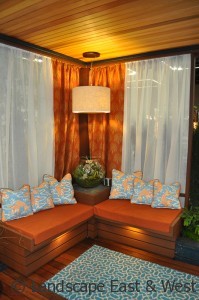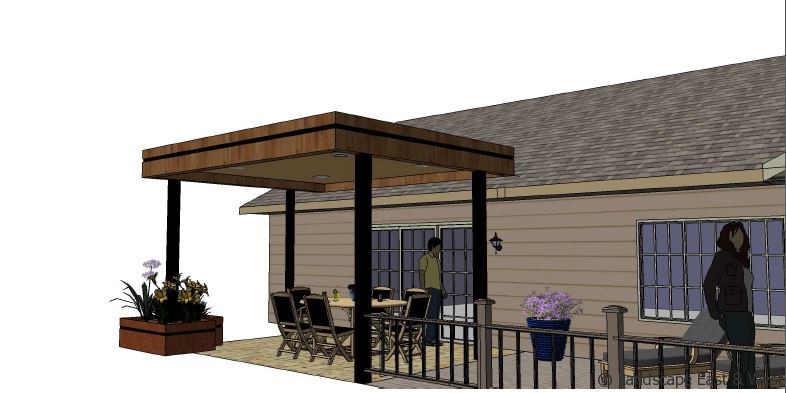Choosing the Right Covered Structure or Pergola Design by Bjorn Nordquist, Landscape East & West
 Outdoor covered structures such as pergolas create cozy, functional, year-round spaces that extend a homes’ living space into their gardens. Because covered patios and decks have become a sought-after element among homebuyers, homes with covered structures tend to earn a higher resale price. In a sense, a wood pergola or other covered structure adds functional square footage to the home. After adding a covered outdoor structure, many homeowners find they enjoy the outdoors more frequently throughout the year. And in our drizzly Pacific Northwest climate, being able to enjoy the outdoors for more of the year is a huge plus.
Outdoor covered structures such as pergolas create cozy, functional, year-round spaces that extend a homes’ living space into their gardens. Because covered patios and decks have become a sought-after element among homebuyers, homes with covered structures tend to earn a higher resale price. In a sense, a wood pergola or other covered structure adds functional square footage to the home. After adding a covered outdoor structure, many homeowners find they enjoy the outdoors more frequently throughout the year. And in our drizzly Pacific Northwest climate, being able to enjoy the outdoors for more of the year is a huge plus.
Where to Find Inspiration for Outdoor Covered Structures
 Magazines, books and design websites are excellent sources of inspiration, but don’t hesitate to snap a picture of a friend or neighbor’s coveted outdoor space. Or, if you’re more of a writer, describe what you’re looking for in a paragraph or two. This will help your landscaping contractor understand what it is you’d like to achieve with your covered structure or wood pergola. Will you be dining, socializing or relaxing under your gazebo or pergola? Think about how you will use your outdoor space and how many people might be enjoying it. Also, as you gather inspiration, discuss the costs involved with your contractor to help set a general budget. This will allow your contractor to keep materials and design elements within reach.
Magazines, books and design websites are excellent sources of inspiration, but don’t hesitate to snap a picture of a friend or neighbor’s coveted outdoor space. Or, if you’re more of a writer, describe what you’re looking for in a paragraph or two. This will help your landscaping contractor understand what it is you’d like to achieve with your covered structure or wood pergola. Will you be dining, socializing or relaxing under your gazebo or pergola? Think about how you will use your outdoor space and how many people might be enjoying it. Also, as you gather inspiration, discuss the costs involved with your contractor to help set a general budget. This will allow your contractor to keep materials and design elements within reach.
Building Outdoor Structures: Common Challenges & Special Considerations
Typical challenges to keep in mind when covering your outdoor living space include:
Sufficient structural support. Unfortunately, some contractors use quick, weak methods to build outdoor structures – such as using only brackets to connect a post to its footing. Just like indoor rooms, outdoor rooms must meet basic structural standards to be safe. For a strong outdoor covered structure, posts should be sunk a minimum of 3 feet into the ground for lateral support. Further lateral bracing is generally required in the upper structure as well. To dress up your design, add trim to the posts or mix up materials – surrounding the base of the post with brick, stone or wood that adds architectural detail.
Focus on drainage. If your covered structure’s drainage is weak, it will soon become the kind of damp, leaky and generally miserable place where no family members ever want to hang out. Make sure your contractor has strong plans for the placement of gutters. Good drainage is especially important in wet locales such as Portland. The angle of the roof is key in achieving proper drainage, so gather all the roofing materials you will need up front, and make sure they are rated for the slope in your design.
Obtain the requisite permits. Obtaining permits and following city codes will help you avoid headaches and possible hefty fines down the road. Most cities have requirements on how far any structure must be set back from property lines, for instance. Work with a contractor who has a proven record of meeting municipal requirements.
 Top Materials for Outdoor Covered Structures in the Pacific Northwest
Top Materials for Outdoor Covered Structures in the Pacific Northwest
1. Cedar – Good mix of durability and beauty.
2. Pressure treated wood – For any material that will be in contact with the ground. Its chemical preservatives help prevent rot and mold growth. One way to avoid the ugliness of pressure treated wood is to use it for posts and then wrap it with cedar on all sides for concealment.
3. Juniper – Naturally resistant to rot, so no preservative chemicals are needed. And the rustic look of juniper is much more attractive than pressure treated wood. However, juniper is not yet available for structural use, so it is best to use it in combination with materials.
We do not recommend using fir for a wood pergola – this timber won’t survive the Pacific Northwest rain. We also stay away from vinyl or plastics because they tend to look grimy as time passes.
At Landscape East & West, we build all manner of wood structures according to our clients’ preferences, needs and budgets. In the past, we’ve built freestanding roof structures; attached deck and patio covers; and wood pergolas. We are happy to customize designs with optional bells and whistles such as skylights, recessed lighting, infrared heaters, outdoor speakers, art elements and ceiling fans. We can even add a patio cover to an existing pergola to keep you dry in all seasons. To complement the structure, we also offer fireplaces, fire pits, outdoor kitchens, water elements and even outdoor home theater options. You may also want to dress up your outdoor living area with outdoor fabrics, including curtains and pillows.
 Our process for adding a covered structure is as follows: First, we discuss the clients’ goals in building the pergola or patio cover. (There is no charge for this initial consultation.) Once we’re sure we understand the project thoroughly – as well as its budget – we suggest creative ideas that meet the needs and are on target cost-wise. If we can find a solution that sounds appealing we’ll provide a conceptual cost proposal including any design fees if applicable. Our design will include a spatial layout, proposed structural design, material choices, color options and permitting information. We can offer traditional plans and elevation drawings, but we are also able to deliver our ideas in a modern virtual 3D experience. We can even allow you to see what the outdoor structure will look like from “inside” your kitchen or living room.
Our process for adding a covered structure is as follows: First, we discuss the clients’ goals in building the pergola or patio cover. (There is no charge for this initial consultation.) Once we’re sure we understand the project thoroughly – as well as its budget – we suggest creative ideas that meet the needs and are on target cost-wise. If we can find a solution that sounds appealing we’ll provide a conceptual cost proposal including any design fees if applicable. Our design will include a spatial layout, proposed structural design, material choices, color options and permitting information. We can offer traditional plans and elevation drawings, but we are also able to deliver our ideas in a modern virtual 3D experience. We can even allow you to see what the outdoor structure will look like from “inside” your kitchen or living room.
From here, we revise our design to achieve a final plan that perfectly fits the homeowner’s needs. With the revised plan, we give firm costs and alternative cost options such as different material choices. The final proposal is very detailed to clearly set the expectations for both of us. With this information, clients are able to find the perfect combination for their needs and budget. Finally, our skilled craftsmen install the structure just as specified. We handle all the inspections, permits and subcontractors, if any. The design process can take anywhere from one to four weeks, and the average structure installation might take one to three weeks to complete. From there, you can begin enjoying your new outdoor living room and for years to come.
If you’re interested in learning more about a custom-designed covered structure from Landscape East & West, get in touch with us and let the ideas start flowing.
 Contributing author Bjorn Nordquist is the Sales Manager at Landscape East & West, Portland, Oregon’s landscaping and design professionals. Bjorn takes great pleasure in providing clients with beautiful outdoor living spaces that fit their needs perfectly.
Contributing author Bjorn Nordquist is the Sales Manager at Landscape East & West, Portland, Oregon’s landscaping and design professionals. Bjorn takes great pleasure in providing clients with beautiful outdoor living spaces that fit their needs perfectly.
